Crushing the Competition: A Step-by-Step Guide to Effective Product Competitor Analysis
-
UncategorizedUpdatedPosted:
On this page
In the world of product marketing, staying ahead of the competition is not just an advantage—it’s imperative. Competitor analysis is a cornerstone strategy to comprehend market trends, dissect competitors’ strengths and weaknesses, and refine product strategies to deliver unmatched value to customers.
The essence of competitor analysis in product marketing lies in the rigorous evaluation of the strategies and tactics employed by market rivals.
This thorough examination serves as a guiding light for businesses, helping them identify what sets them apart in the market, understand how customers perceive their products, seize opportunities in the marketplace, learn from their competitors’ experiences, and craft effective marketing strategies.
The Importance of Competitor Analysis
Diving into the world of competitive business makes it clear: competitor analysis is crucial for any company aiming to succeed.
It’s like having a special compass that guides businesses smoothly toward their goals.
In discussing competitor analysis, we’re exploring a strategic approach to understand the market’s essence. Through careful analysis, businesses can untangle market trends by examining competitors’ offerings, services, prices, and promotional strategies.
This granular understanding helps pinpoint customer needs, demands, expectations, and behaviors, illuminating potential market gaps and opportunities.
Moreover, there’s a wealth of insights waiting to be discovered in understanding customer perspectives. It’s not just about recognizing a preference for Product A over Product B—it’s about comprehending the reasons behind it.
By deeply exploring competitors’ branding, positioning, messaging, reputation, and customer feedback, you can gain a clear understanding of your product’s position in the market. These insights help businesses understand what influences customer satisfaction and loyalty, serving as a crucial guide for making informed decisions.
This especially comes in handy when refining product strategy. When businesses can spot where competitors excel or struggle, they can fine-tune their strategies precisely.
By learning from competitors’ performance metrics, innovative methods, and unique features, businesses can pinpoint their strengths and weaknesses. This insight is incredibly valuable, allowing companies to adopt successful practices and avoid mistakes.
Finally, competitor analysis serves as a watchful guardian. By keeping a close eye on competitors, businesses can better predict market changes, ensuring they stay relevant and innovative in their industry.
Now that you understand the importance of competitor analysis, let’s now explore how to effectively conduct it.
Preparing for Competitor Analysis
Before diving headfirst into the sea of competitor analysis, it is important to set clear objectives. What are the burning questions that need answers? What insights are being sought? How will this knowledge shape the future of the business? Knowing the why behind the analysis will ensure the data extracted is comprehensive and relevant.
Next in line is the task of identifying key competitors. After all, not every competitor wields the same influence or relevance.
So, when sorting competitors, businesses should think about things like how much of the market they have, what products they offer, how good those products are, how they price them, who they sell to, and where they operate. These details can help pinpoint the main competitors, making the analysis easier to compare and understand.
Equally important is the preparatory stage, where collecting the necessary tools, resources, and data sources becomes pivotal. It’s like putting together a toolkit; having suitable instruments can distinguish between a superficial assessment and an insightful analysis.
Step-by-Step Guide to Effective Competitor Analysis
Step 1: Identify Competitors
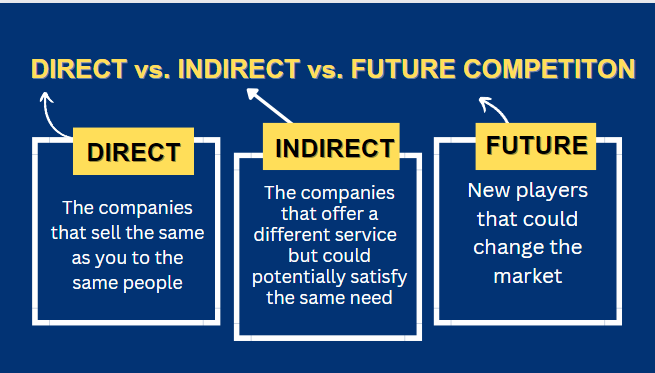
Effective competitor analysis in business and marketing hinges on identifying and categorizing competitors into three key segments – direct, indirect, and future competitors.
Direct competitors are those offering similar products or services to your own, vying for the same audience and posing an immediate threat to your market share.
While not offering identical solutions, indirect competitors address the exact needs from different angles and can influence market dynamics over time.
Lastly, future competitors are emerging players with the potential to disrupt the market, warranting early identification and strategic preparation.
This way of sorting helps to focus and deeply understand your competition. It also allows for allocating resources wisely and understanding their strategies and position in the market more clearly.
Once you’ve sorted your competitors into these segments, it’s crucial to pinpoint their focus on specific niche markets. Start by identifying relevant niche markets for your business and industry, which can be done through market research, analyzing customer feedback, or using online tools.
For every niche, compile a list of competitors providing products or services for that specific market. This involves conducting web searches, exploring social media, or using specialized online tools.
Analyzing the competitors’ offerings, pricing, marketing strategies, reviews, and market share is essential. Visiting their websites, reading their blogs, or utilizing tools can facilitate this.
Finally, compare and contrast the competitors, identifying their strengths, weaknesses, and any market opportunities. This helps to craft a unique value proposition and establish a competitive advantage in your market.
Step 2: Gather Information
To collect key details about your competitors, it’s essential to thoroughly explore their websites. Look closely at their product specifics, features, prices, and messaging.
Next, dive into their social media presence, scrutinizing engagement levels, customer sentiment, and their adeptness in handling feedback.
Social media platforms have a huge influence on brand perception and customer relationships. Look closely at their content strategy, including blogs, eBooks, and other materials, to gauge their thought leadership within the industry.
High-quality content can position a company as a trusted authority, making content analysis a vital component of your competitor research efforts.
Step 3: Product Features and Differentiation
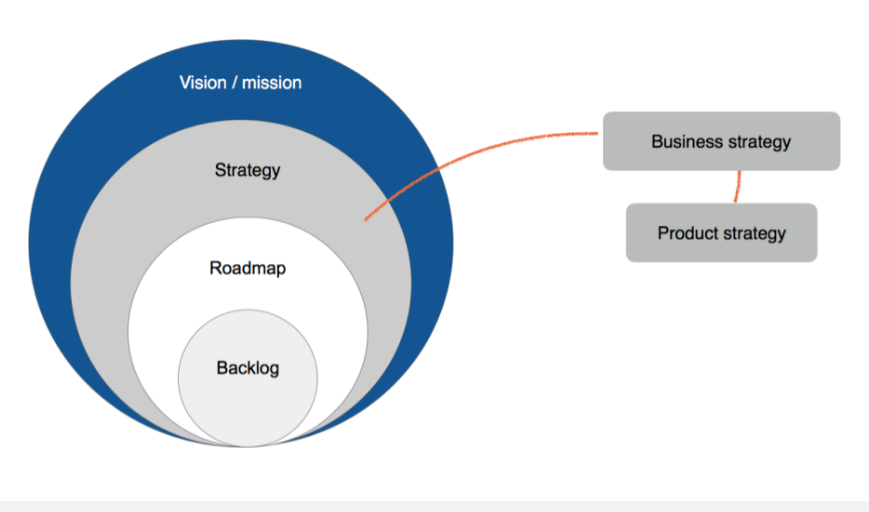
In crafting a compelling value proposition, dissecting your competitors’ product features and pinpointing opportunities for differentiation is a non-negotiable. Start by creating a feature matrix that compares your product’s offerings to your rivals, highlighting areas where your product shines.
Additionally, delve into their Unique Selling Proposition (USP) to discern how they position their unique features to stand out. once again, scrutinize the messaging and strategies they employ to emphasize their strengths.
This analysis is instrumental in identifying the white spaces in the market where your product can excel and provide something distinct that others don’t—a critical foundation for building your competitive advantage.
Step 4: Pricing Analysis
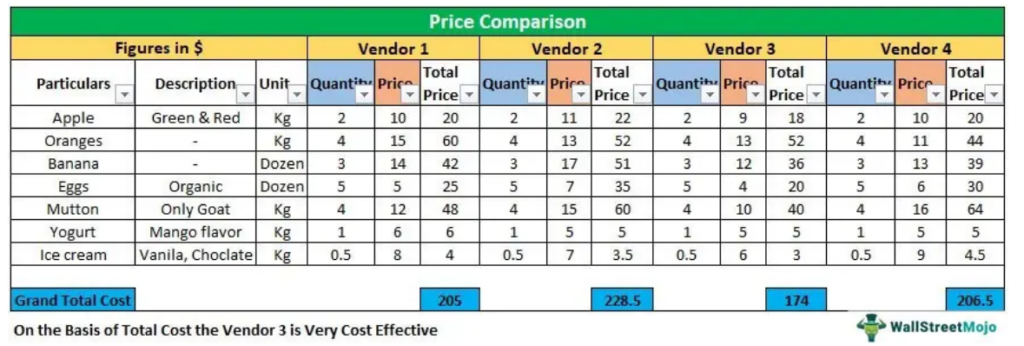
Pricing significantly shapes how customers perceive your product’s value. Understanding how competitors price their products is crucial for setting your pricing strategy.
Initiate the process by comparing your pricing against competitors to position yourself advantageously. Determine the price range and average pricing within your product category in the market.
Then, define your pricing objective and strategy, which might involve pricing higher, lower, or equally to competitors, contingent on your unique value proposition, target market, and competitive advantages.
In addition, evaluate how competitors justify their pricing based on the value they provide customers. Dig deeper into pricing specifics including discounts, bundles, or subscription models, to understand their impact on sales and customer loyalty.
Step 5: Marketing and Messaging
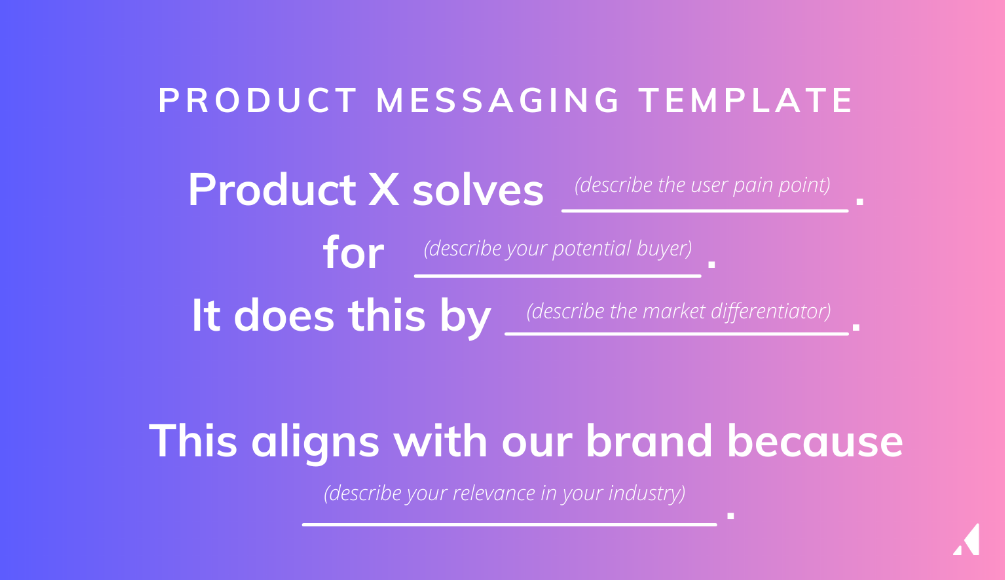
Understanding your competitors’ marketing tactics and messaging helps to refine your own messaging and connect with your target audience as quickly as possible.
Begin by evaluating the language and tone they employ in their messaging to grasp their brand personality and audience engagement strategies.
Determine the specific demographic they cater to and the pain points they address, as this insight will empower you to tailor your marketing efforts more effectively.
You can delve into their content strategy, examining the types of content they produce and where they distribute it. This understanding can serve as inspiration for your content marketing endeavours.
Step 6: Customer Reviews and Feedback
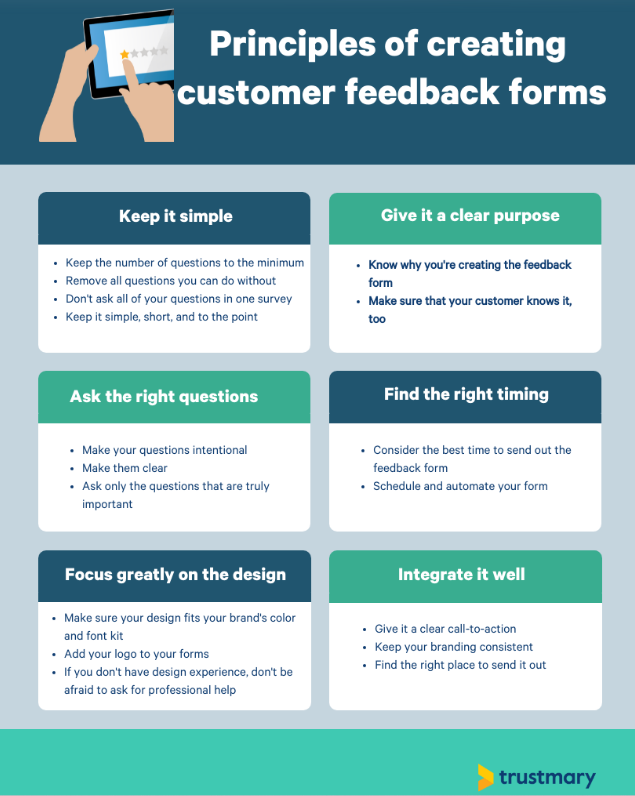
Leveraging customer feedback is a goldmine within competitor analysis, offering insights to identify and address gaps in your rivals’ products.
Look into online reviews and feedback on review sites, forums, and social media platforms, paying particular attention to recurring complaints or unmet customer needs.
By pinpointing the pain points and customer dissatisfaction, you can uncover valuable opportunities for improvement. Use this feedback to guide your product development efforts and tailor your offerings to better meet customer needs and desires.
Step 7: SWOT Analysis
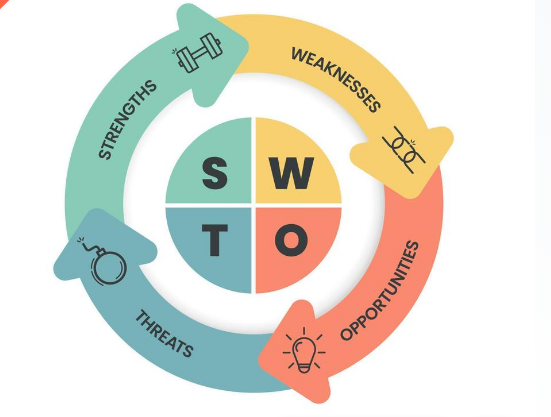
Conducting a comprehensive SWOT analysis of your competitors helps you understand their market position holistically. Start by delineating their strengths and weaknesses, shedding light on their internal factors contributing to success or hindering growth.
Simultaneously, identify external factors such as industry trends, regulatory changes, economic shifts, or emerging technologies that can serve as opportunities or threats.
By juxtaposing your strengths and weaknesses against your competitors, you can discern what sets your product apart and why it holds a superior position in the market. This analysis forms the bedrock of strategic decision-making and informs your approach to outmanoeuvring the competition.
Applying Insights to Your Product Strategy
Refine Product Roadmap
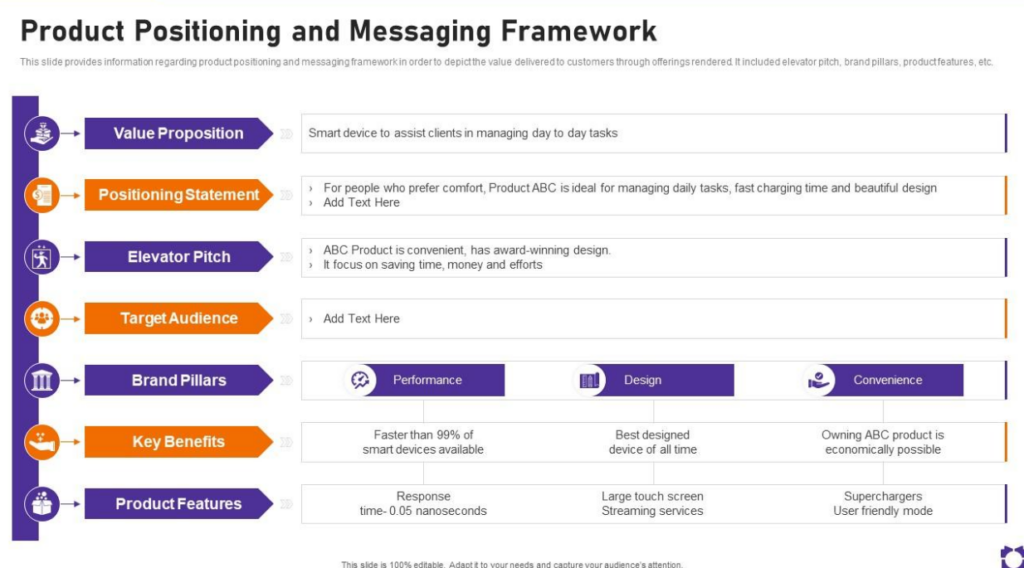 Refining your
product roadmap
is pivotal in ensuring your product remains competitive and
aligned with market dynamics. Integrating competitor insights into
your product strategy gives you a valuable edge in addressing
market gaps and maintaining a leadership position. To begin, it’s
essential to incorporate these insights into your product
development plan.
Refining your
product roadmap
is pivotal in ensuring your product remains competitive and
aligned with market dynamics. Integrating competitor insights into
your product strategy gives you a valuable edge in addressing
market gaps and maintaining a leadership position. To begin, it’s
essential to incorporate these insights into your product
development plan.
This means leveraging your analysis findings to inform the direction and priorities of your product roadmap. Key insights from competitors, such as their strengths and weaknesses, market gaps, customer preferences, and industry trends, should guide your decision-making process.
Once integrated, your next focus should be addressing the identified gaps where your competitors fall short. These gaps represent opportunities to provide a more comprehensive solution to your target audience.
Whether enhancing the quality, introducing innovations, increasing the overall value, or improving customer service, your product roadmap should reflect a strategic response to these gaps.
Consider using prototyping MVP (Minimum Viable Product) development, and experimentation to validate your solutions effectively. These approaches allow you to gather customer feedback, measure outcomes, and refine your product offerings. By continuously refining your product roadmap based on competitor insights and customer feedback, you can adapt and thrive in a dynamic market, ultimately ensuring the sustained success of your product.
Enhance Marketing Strategy
Enhancing your marketing strategy ensures that your product competes effectively and resonates with your target audience. Tailoring your marketing efforts based on competitive analysis can significantly contribute to this success. Here are some steps to enhance your marketing strategy based on insights from your competitors:
First and foremost, focus on highlighting your product’s unique strengths that competitors lack. It’s essential to identify the aspects of your product that set it apart and provide genuine value to your customers.
This might include superior quality, innovative features, exceptional value, or outstanding customer service. These unique strengths should be central to your marketing messaging, as they serve as key differentiators and reasons for customers to choose your product over alternatives.
Next, address the pain points competitors are not effectively solving in your marketing efforts. Identify your target audience’s challenges or needs that your competitors do not adequately address.
You can resonate more deeply with your audience by showcasing how your product addresses these pain points and offers effective solutions. This can involve crafting content, such as blog posts, social media updates, or email campaigns, that directly speak to these issues and demonstrate how your product provides a better alternative.
To effectively implement these strategies, utilize various tools and data sources to refine your messaging and target your audience. Web analytics tools like Google Analytics can help you track website performance and customer behavior.
Social media analytics tools like Hootsuite can monitor your social media presence and engagement. Content marketing tools such as HubSpot can aid in creating and distributing content that highlights your unique strengths and addresses pain points.
Email marketing tools like Mailchimp can enable you to send personalized and targeted emails that emphasize how your product solves customers’ problems. By aligning your marketing strategy with competitive insights, you can ensure that your messaging resonates strongly with your audience and sets your product apart in the market.
Pricing and Positioning
Adjusting your pricing and positioning based on competitive analysis is fundamental to crafting a successful marketing strategy. When it comes to pricing, it’s essential to tailor your approach in line with the competitive landscape and how customers perceive the value of your product.
For instance, if you offer a premium product that surpasses competitors in terms of quality and features, adopting a premium pricing strategy can communicate exclusivity and prestige to your customers, exemplified by brands like Rolex in the luxury watch industry.
On the other hand, if you’re entering a crowded market, a penetration pricing strategy, like Netflix’s initial low monthly fee for streaming, can help attract cost-conscious customers and expand market share rapidly. Similarly, positioning your product based on its value is crucial.
Whether highlighting unique features justifying premium pricing, emphasizing affordability for a mass market, or showcasing reliability and trustworthiness in a competitive landscape, aligning your positioning with pricing strategy is vital for resonating with your target audience and effectively capturing your product’s value.
Continuous Monitoring and Adaptation
Given the ever-evolving nature of markets, continuous competitor monitoring is essential. Staying alert helps businesses prepare for changes among the competition.
Additionally, maintaining adaptability and readiness to modify strategies based on newfound insights can help you with maintaining relevance in the market over time.
The principle of iterative improvement is foundational for continuous enhancement. Regularly updating product and marketing strategies, informed by fresh insights, ensures businesses remain agile and adaptable in market evolution.
Anchoring Success by Staying Ahead
Competitor analysis in product marketing is non-negotiable for businesses aspiring to carve a niche in today’s competitive arena. This comprehensive guide serves as a blueprint for conducting effective competitor analysis, aiding companies in defining their unique value proposition, understanding customer perceptions, and identifying market opportunities.
Fine-tuning product and marketing strategies, adjusting pricing and positioning, and maintaining vigilance through continuous monitoring and adaptation are essential in securing a competitive edge.
The constant commitment to competitor analysis is pivotal as it is a cornerstone for success in the ever-fluctuating business landscape.
Implementing this thorough competitor analysis approach will give product marketers the necessary insights and strategies to flourish in their respective markets. The emphasis on learning from competitors, discerning market trends, and applying these insights to product strategy formulates a recipe for success.
Want to send more personalized mobile and email messages to your users?
Learn moreCustomer story

How Vero helps Dribbble take full advantage of their customer data to improve personalization
